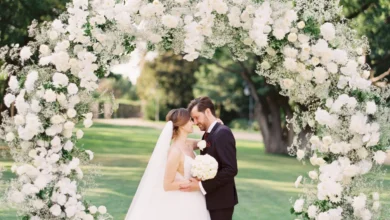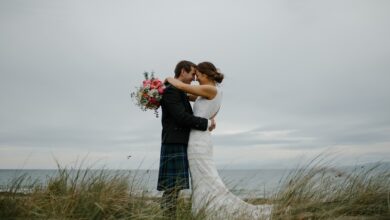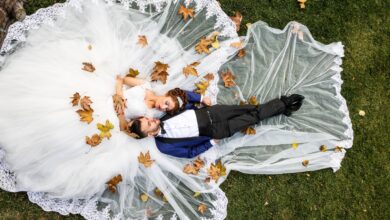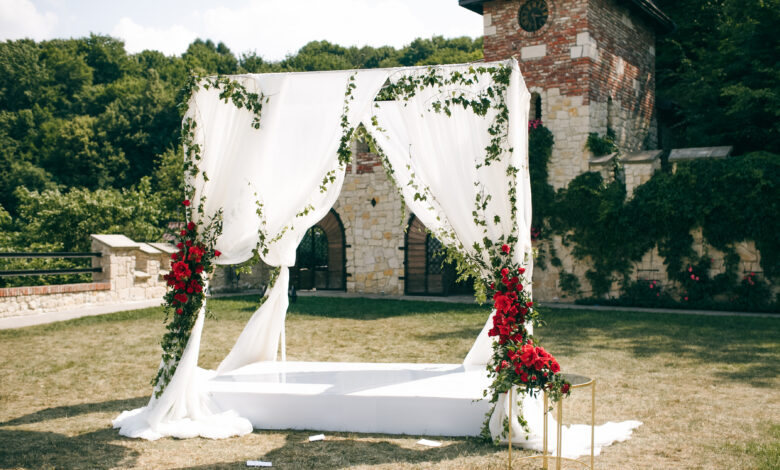
A Wedding Arch
A wedding arch is a decorative structure that is typically used during wedding ceremonies. It serves as a focal point and creates a beautiful backdrop for the couple as they exchange their vows.
The arch is usually positioned at the altar or ceremony location and can be adorned with various decorations such as flowers, greenery, fabric, or other decorative elements to match the wedding theme.
Wedding arches come in a variety of styles, shapes, and sizes, allowing couples to choose one that suits their preferences and complements the overall wedding aesthetics.
Why are wedding arche used in weddings?
Arches are used in weddings for several reasons, including:
Symbolic Significance: Wedding arches hold symbolic meaning in many cultures and traditions. The arch represents the gateway or threshold to a new chapter in the couple’s lives, symbolizing the beginning of their journey together as a married couple. It serves as a visual representation of the sacred space where the vows are exchanged.
Decorative Focal Point: A wedding arch creates a visually appealing focal point during the ceremony. It adds a touch of elegance, charm, and romance to the overall wedding decor. The arch serves as a backdrop for the couple as they stand at the altar, enhancing the aesthetic appeal of the ceremony and providing a picturesque setting for photographs.
Frame for Photography: Wedding arches provide a frame for capturing beautiful and memorable photographs. The arch serves as a natural frame that can showcase the couple, their bridal party, and their loved ones in a visually pleasing composition. Photographers often utilize the arch to create stunning images that highlight the couple’s love and the ambiance of the ceremony.
Personalization and Customization: Wedding arches offer an opportunity for couples to personalize and customize their wedding ceremony. They can choose the design, style, and decorations of the arch to align with their wedding theme, colors, and overall aesthetic preferences. The arch becomes a reflection of the couple’s unique style and adds a personalized touch to their special day.
Creating an Intimate Space: Wedding arches can help define and create an intimate space within a larger venue. By positioning the arch at the altar or ceremony location, it designates a specific area where the couple and officiant stand, making it feel more intimate and focused. It helps create a sense of closeness and exclusivity during the exchange of vows.
Overall, wedding arches serve both practical and symbolic purposes in weddings. They enhance the visual appeal, provide a meaningful backdrop, and contribute to the overall ambiance and atmosphere of the ceremony.

Shapes of Wedding Arch
Wedding arches come in various shapes and styles, allowing couples to choose one that suits their preferences and complements their wedding theme. Here are some common shapes of wedding arches:
Traditional Arch: The traditional arch features a classic curved shape resembling a half-circle or semi-oval. It is a popular choice for weddings and symbolizes unity and eternity.
Circular or Moon Arch: This arch has a round or crescent shape, creating a unique and romantic look. It can be adorned with flowers, greenery, or fabric to enhance its beauty.
Square or Geometric Arch: A square or geometric-shaped arch adds a modern and contemporary touch to the wedding ceremony. It features clean lines and defined angles, giving it a structured and sophisticated appearance.
Triangular Arch: The triangular arch has three sides that come together at the top, forming a triangular shape. It can represent the connection between the couple and their shared journey.
Heart-Shaped Arch: As the name suggests, the heart-shaped arch has a silhouette resembling a heart. It is a popular choice for romantic and whimsical weddings, symbolizing love and affection.
Natural or Organic Arch: This type of arch incorporates natural elements such as branches, vines, or bamboo poles, giving it a rustic or bohemian feel. The shape can vary depending on the arrangement of natural materials.
Chuppah or Canopy: A chuppah is a traditional Jewish wedding arch that consists of a canopy supported by four poles. It typically has a square or rectangular shape and holds cultural and religious significance.
Remember, these are just a few examples, and there is room for creativity and customization when it comes to wedding arch shapes. Couples can work with wedding planners, decorators, or florists to create a unique and personalized arch design that aligns with their vision for the ceremony.
How to decorate a garden arch for a wedding?
Decorating a garden arch for a wedding is a wonderful way to create a visually stunning focal point and enhance the natural beauty of the outdoor setting. Whether you’re planning a rustic affair, a romantic garden wedding, or a bohemian celebration, a decorated garden arch can add an enchanting touch to your ceremony. Here’s a comprehensive guide on how to decorate a garden arch for a wedding:
Choose a Theme or Style:
Before you start decorating, decide on a theme or style that best suits your wedding vision. Consider the overall atmosphere you want to create – rustic, romantic, bohemian, vintage, or modern. This theme will guide your choice of decorations and ensure a cohesive look.
Select Decorative Materials:
Once you have determined the theme, it’s time to choose the materials for decorating the garden arch. Common options include fresh flowers, greenery, fabric, ribbons, lights, and other decorative elements. Consider the colors, textures, and seasonal availability of these materials to create a harmonious design.
Prepare the Arch:
Ensure that the garden arch is clean and in good condition. If necessary, repair any damages and paint or refinish the arch to match your wedding color scheme. If the arch is freestanding, make sure it is securely anchored in the ground or use weights to stabilize it against wind or movement.
Add a Base Layer of Greenery:
Start by adding a base layer of greenery to the arch. This could be in the form of vines, garlands, or individual foliage such as eucalyptus, ivy, or ferns. Use floral wire or zip ties to secure the greenery, ensuring that it covers the arch’s structure evenly. This base layer provides a lush backdrop for the rest of the decorations.
Incorporate Fresh Flowers:
Integrate fresh flowers into your design to add color and fragrance. Choose blooms that complement your wedding color palette and the season. Create floral clusters or garlands and arrange them along the arch, focusing on the top and sides. Secure the flowers with floral wire or floral tape, ensuring they are firmly attached to withstand any gentle breeze.
Add Draping Fabrics and Ribbons:
To create a soft and romantic look, incorporate draping fabrics or ribbons into the design. Choose fabrics that match your wedding colors and opt for lightweight and sheer materials like tulle or organza. Drape them gracefully over the arch, allowing them to flow naturally. Secure the fabrics with pins or ties, making sure they are evenly distributed and create an elegant drape.
Personalize with Meaningful Touches:
Add personalized elements to the garden arch that reflect your unique story as a couple. Consider incorporating monogrammed initials, hanging photographs of memorable moments, or decorative signs with meaningful quotes or phrases. These personal touches make the arch more intimate and reflective of your journey together.
Illuminate with Lights:
If your wedding is taking place in the evening or you want to create a magical ambiance, incorporate lighting into the arch decoration. String lights, fairy lights, or lanterns can be wrapped around the arch, intertwined with the greenery, or draped along the fabric. The soft, warm glow of the lights will create a romantic and enchanting atmosphere.
Final Touches and Balancing:
Step back and take a holistic view of the decorated garden arch. Make any necessary adjustments to ensure a balanced and visually pleasing composition. Trim any excess foliage or flowers that may look untidy. Consider the surrounding garden and landscape, ensuring that the arch blends harmoniously with its natural surroundings.
Decorating a garden arch for a wedding is an opportunity to let your creativity shine and add a touch of magic to your special day. By carefully selecting materials, incorporating personal touches, and creating a cohesive design, you can transform a simple arch into a breathtaking focal point that sets the stage for an unforgettable ceremony. Enjoy the process of decorating, and let the beauty of nature and your love story guide you in creating a truly remarkable garden arch for your wedding.
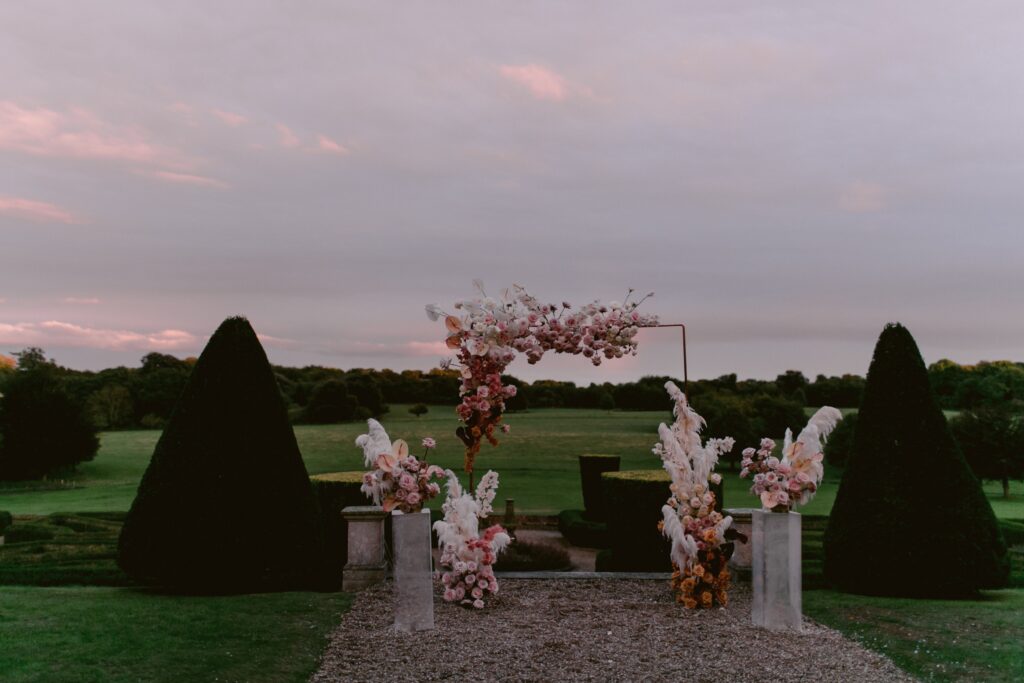
Is a wedding arch religious?
A wedding arch itself is not inherently religious. It is a decorative structure used in wedding ceremonies to create a focal point and provide a beautiful backdrop for the couple. Wedding arches can be found in various cultural and religious traditions, but their use is not exclusive to any particular religion.
In some religious ceremonies, such as Jewish weddings, a specific type of wedding arch called a chuppah is used. The chuppah symbolizes the couple’s new home together and holds religious significance within the Jewish faith. However, the use of a wedding arch does not necessarily imply a religious element in a wedding ceremony.
Many couples choose to incorporate religious elements into their wedding ceremony, such as readings, prayers, or rituals, and the wedding arch can be decorated to align with those religious traditions. For example, flowers, symbols, or colors associated with a specific faith may be incorporated into the arch decoration.
On the other hand, couples who have secular or non-religious ceremonies can also use a wedding arch purely for its aesthetic appeal and symbolism of a ceremonial space without any specific religious connotation.
Ultimately, the significance and meaning of a wedding arch depend on the couple’s preferences, cultural background, and the specific context of the ceremony. It can be adapted to reflect religious, spiritual, or personal beliefs, or it can simply serve as a decorative element in a non-religious ceremony.

